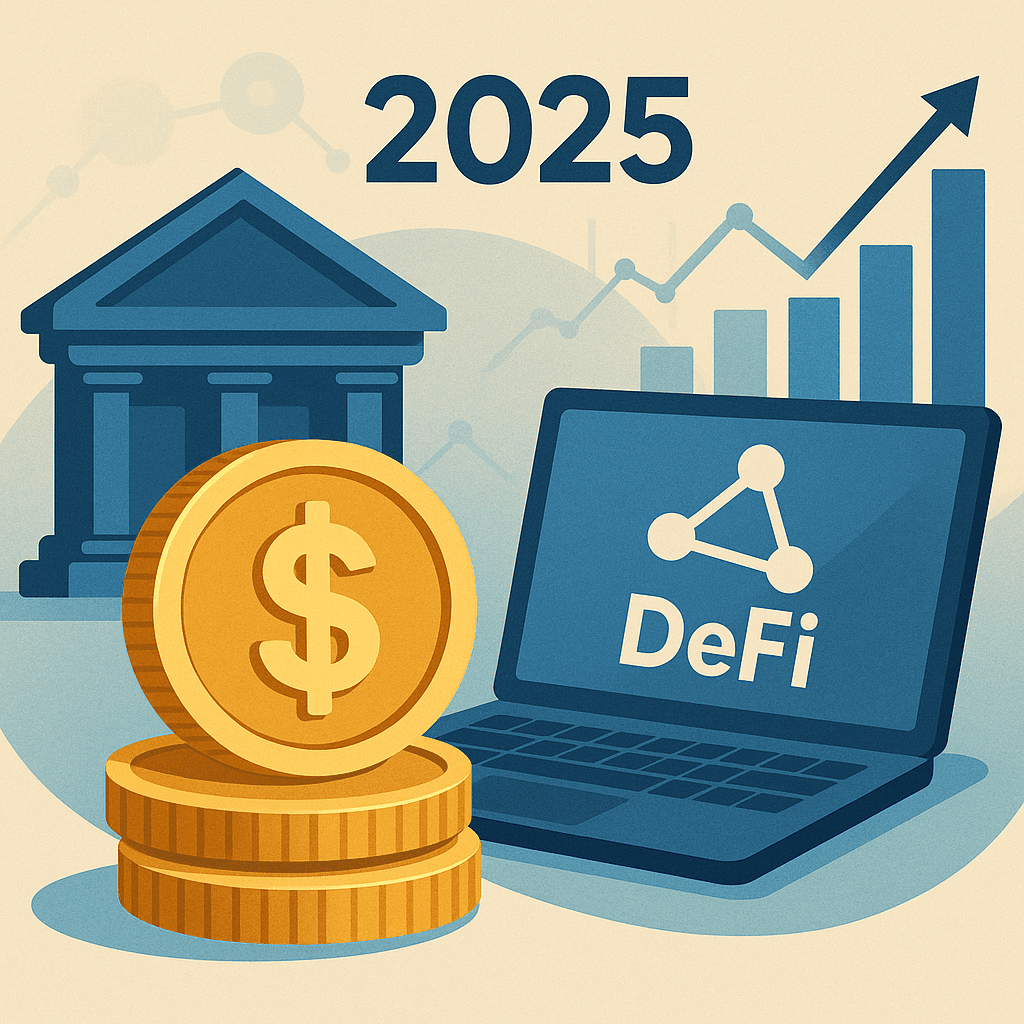How the GENIUS Act, corporate stablecoin adoption, and explosive market growth are forcing traditional banking into the programmable money revolution
The banking industry is experiencing its most significant transformation since the advent of digital payments. After years of regulatory uncertainty around crypto treasury management and DeFi business banking, 2025 has emerged as the inflection point where traditional financial institutions aren't just exploring stablecoins, they're actively building high yield business bank account crypto solutions and comprehensive stablecoin business account offerings.
The U.S. Senate's historic passage of the GENIUS Act in June 2025 with a decisive 68-30 vote represents more than legislative progress, it signals the end of the waiting game for America's largest banks. From JPMorgan's expanding programmable yield initiatives to reports that Amazon and Walmart are exploring corporate stablecoins, the message is unmistakable: instant yield DeFi and stablecoin payment processor technology have moved from experimental curiosity to strategic imperative.
The Perfect Storm: Three Critical Forces Driving Banking's Stablecoin Revolution
1. Regulatory Clarity Creates the Foundation for DeFi Treasury Tools
For years, banks cited regulatory uncertainty as the primary barrier to offering DeFi treasury tools and crypto cash management for businesses. According to industry surveys, 85% of financial institutions identified regulatory concerns as a major obstacle in 2023. The GENIUS Act has eliminated this excuse entirely.
What the GENIUS Act Enables for Business Banking:
The legislation creates the first comprehensive federal framework for stablecoin treasury strategy in the United States, establishing three categories of permitted stablecoin issuers:
Bank subsidiaries: Existing depository institutions can launch stablecoin services
Federal nonbank issuers: OCC-approved entities can compete directly with banks
State-qualified issuers: Smaller players can operate under state frameworks
More importantly for USDC yield account for companies, the bill prevents custodied assets from being classified as liabilities on financial statements. This directly addresses balance sheet complications that previously made banks hesitant to offer non-custodial yield account services.
Global Regulatory Momentum:
Europe's MiCA regulation provides similar clarity across EU markets
Only 18% of European institutions now view regulation as a barrier to stablecoin yield infrastructure
12 countries introduced new stablecoin-specific regulatory frameworks in 2024
2. Competitive Pressure: $27.6 Trillion Market Demands Response
The stablecoin market has reached undeniable scale. Stablecoin adoption 2025 statistics reveal transfer volumes of $27.6 trillion in 2024, surpassing the combined transaction volume of Visa and Mastercard by 7.68%. This isn't crypto speculation—it's mainstream financial infrastructure that banks can no longer ignore.
Corporate Stablecoin Initiatives Reshaping Competition:
Major Retailers Entering the Space:
Amazon ($638 billion annual revenue) exploring internal stablecoins
Walmart (>$100 billion e-commerce sales) developing payment solutions
Expedia Group and major airlines considering stablecoin programs
All seeking to reduce billions in payment processing fees through zero fee payment processor crypto alternatives
Banking Consortium Formation: JPMorgan Chase, Bank of America, Wells Fargo, and Citigroup are exploring joint stablecoin development. This unprecedented collaboration signals that even competitors recognize stablecoins as critical infrastructure, not optional technology.
Payment Industry Integration:
Fiserv announced stablecoin initiatives for 90 billion annual transactions
Shopify confirmed USDC payment integration by end of 2025
Mastercard and Visa expanding stablecoin transaction support across 10+ networks
3. Explosive Customer Demand for Crypto Business Banking Solutions
Stablecoin User Growth Statistics (2024-2025):
Active addresses grew 53% year-over-year (19.6M to 30M users)
Monthly transfer volumes increased 115% ($1.9T to $4.1T)
Total supply expanded 63% ($138B to $225B)
Peak monthly volume reached $5.1 trillion in December 2024
Enterprise Requirements Driving Adoption:
41% of institutions cite fast, reliable payouts as non-negotiable
34% require compliance and transparency as essential criteria
49% of financial institutions already using stablecoins
41% additional institutions in pilot or planning phases
Market Projection: The $2.8 Trillion Opportunity by 2028
How to Earn Yield on Business Funds is becoming a core banking question as market projections suggest explosive growth ahead. Bernstein Research forecasts global stablecoin circulation reaching $2.8 trillion by 2028—representing 13x growth from current levels.
Key Growth Drivers:
Infrastructure Maturation: Eight major banks have launched stablecoins: JPMorgan (JPM Coin), Société Générale (EURCV), ANZ Bank (A$DC), Custodia Bank, Vantage Bank, AMINA Bank, and Sumitomo Mitsui. Early adopters demonstrate both viability and competitive advantage in Solana DeFi yield and passive income DeFi stablecoins strategies.
Cross-Border Payment Efficiency:
Settlement times: minutes vs. days for traditional rails
Cost reduction: significantly below correspondent banking fees
USDC for cross border payments becoming standard for international businesses
Revenue Generation Model: Unlike traditional payment processing (cost center), yield generating smart accounts create new revenue streams. Stablecoin issuers typically use short-term Treasuries as reserves, earning approximately 4% yield in current markets.
What Banks Are Building: Beyond Basic Stablecoin Services
Multi-Modal DeFi Infrastructure for Business Clients
Conversion and Custody Services:
Fiat-to-stablecoin conversion with institutional-grade security
Crypto savings account with yield options for corporate treasuries
Integration platforms embedding stablecoin functionality in existing banking
Advanced Treasury Management:
Earn yield on idle capital through automated DeFi protocols
Programmable money APIs enabling conditional payments and smart contracts
Yield on crypto payments that turn transaction processing into revenue generation
Corporate Banking Innovation:
Speed-to-revenue improvements in merchant settlement
B2B cross-border flow optimization
On-chain subscription management for recurring business payments
The RebelFi Model: Instant Yield as Competitive Advantage
While traditional banks focus on basic stablecoin custody, innovative platforms like RebelFi are pioneering instant yield infrastructure that transforms every transaction into a revenue opportunity.
Key Features Banks Can Learn From:
Pull-based crypto payments with yield continuity until collection
Yield-bearing crypto payment tools that eliminate idle capital
Smart wallet with yield functionality for business accounts
DeFi yield routing that automatically optimizes returns
This approach addresses the core question facing businesses: best way to earn interest on USDC 2025 while maintaining operational efficiency.
Competitive Positioning: Early Movers vs. Late Adopters
First-Mover Advantages in Stablecoin Banking
Market Position Benefits:
Primary channel status for business stablecoin access
Customer relationship ownership during digital transition
Infrastructure investment amortization across growing user base
Technical Capabilities Required:
Real-time wallet infrastructure
Embedded transaction screening and compliance
Multi-network connectivity for global settlement
DeFi infrastructure for banks supporting yield optimization
Risk of Delayed Action
Banks waiting for "perfect" regulatory clarity face mounting risks:
Customer migration to fintech competitors
Revenue loss to corporate stablecoin initiatives
Infrastructure costs increasing as talent becomes scarce
Regulatory compliance becoming more complex, not simpler
Regional Adoption Patterns: Global Stablecoin Strategy
North America: Infrastructure Maturity
Institutional readiness highest globally
Stablecoin business account offerings becoming standard
Wide range of payment flows being operationalized
Regulatory framework providing competitive moat for compliant institutions
Europe: Deliberate Implementation
MiCA regulation creating clear operational paths
58% of institutions using or planning stablecoin payments
Focus on crypto payment adoption by banks rather than pure innovation
Emphasis on compliance-first approaches
Asia-Pacific: Rapid Adoption
50% of global stablecoin activity by transaction volume
Emerging market focus on USDC for cross border payments
Corporate treasury applications leading adoption
Currency risk mitigation driving business usage
Frequently Asked Questions About Banks and Stablecoins
How do stablecoins work for businesses?
Stablecoin business accounts allow companies to hold, send, and receive digital dollars that maintain stable value. Unlike volatile cryptocurrencies, stablecoins are pegged 1:1 to USD, providing predictable value for business operations while enabling faster, cheaper transactions than traditional banking.
What yield can businesses earn on stablecoin accounts?
Current high yield business bank account crypto solutions offer 6-8% APY through integration with DeFi lending protocols. This represents a significant improvement over traditional business checking accounts that typically offer near-zero interest rates.
Are stablecoins safe for corporate treasuries?
Under the GENIUS Act, regulated stablecoin issuers must maintain full reserves in cash or cash equivalents (typically U.S. Treasuries), with monthly audits and transparency requirements. This provides institutional-grade safety for crypto treasury management applications.
How do banks compete with corporate stablecoins?
Banks offer regulatory compliance, existing customer relationships, and integrated services that corporate stablecoins cannot provide. By adding programmable yield and DeFi treasury tools to traditional banking, institutions can offer superior value propositions.
What's the difference between CBDCs and stablecoins?
CBDCs vs stablecoins represents government-issued vs. privately-issued digital currency. Stablecoins offer faster innovation, higher yields, and programmable features, while CBDCs provide government backing but limited functionality.
Implementation Roadmap: How Banks Can Start Today
Phase 1: Foundation Building (0-6 months)
Stablecoin custody and conversion services
Crypto on/off ramp for businesses integration
Basic USDC savings account offerings for corporate clients
Phase 2: Service Enhancement (6-12 months)
Yield generating smart accounts with DeFi integration
Crypto point of sale system support for merchant clients
Accept USDC payments infrastructure for business customers
Phase 3: Advanced Capabilities (12+ months)
Programmable money APIs for custom business logic
Yield engine for fintech partners and white-label solutions
Launch DeFi-powered banking product with full automation
The Strategic Imperative: Act Now or Fall Behind
The convergence of regulatory clarity, competitive pressure, and customer demand has created an unprecedented transformation window. As Treasury Secretary Scott Bessent noted, the U.S. stablecoin market could grow eightfold to over $2 trillion in the coming years.
Key Success Factors:
Infrastructure investment: Building capabilities before demand peaks
Regulatory advantage: Using compliance as competitive differentiation
Customer education: Helping businesses understand how stablecoins work for businesses
Partnership strategy: Collaborating with DeFi infrastructure providers like RebelFi
Conclusion: The Digital Dollar Revolution Demands Banking Leadership
The question facing bank executives isn't whether to embrace DeFi business banking, it's how quickly they can deploy comprehensive stablecoin treasury strategy before competitors capture market share.
Institutions that move beyond basic compliance to genuine innovation through instant yield DeFi and programmable yield capabilities will reclaim their role as primary financial infrastructure providers. Those who wait risk becoming mere custodians of an increasingly obsolete system.
The year 2025 will be remembered as banking's digital transformation moment. The only question is which institutions will lead that change, and which will be left managing legacy systems while competitors power the programmable money economy.
Ready to explore how instant yield infrastructure can transform your business banking strategy? Discover how RebelFi's yield generating smart accounts help forward-thinking companies turn every payment into a revenue-generating opportunity while maintaining the security and compliance standards your business demands.



